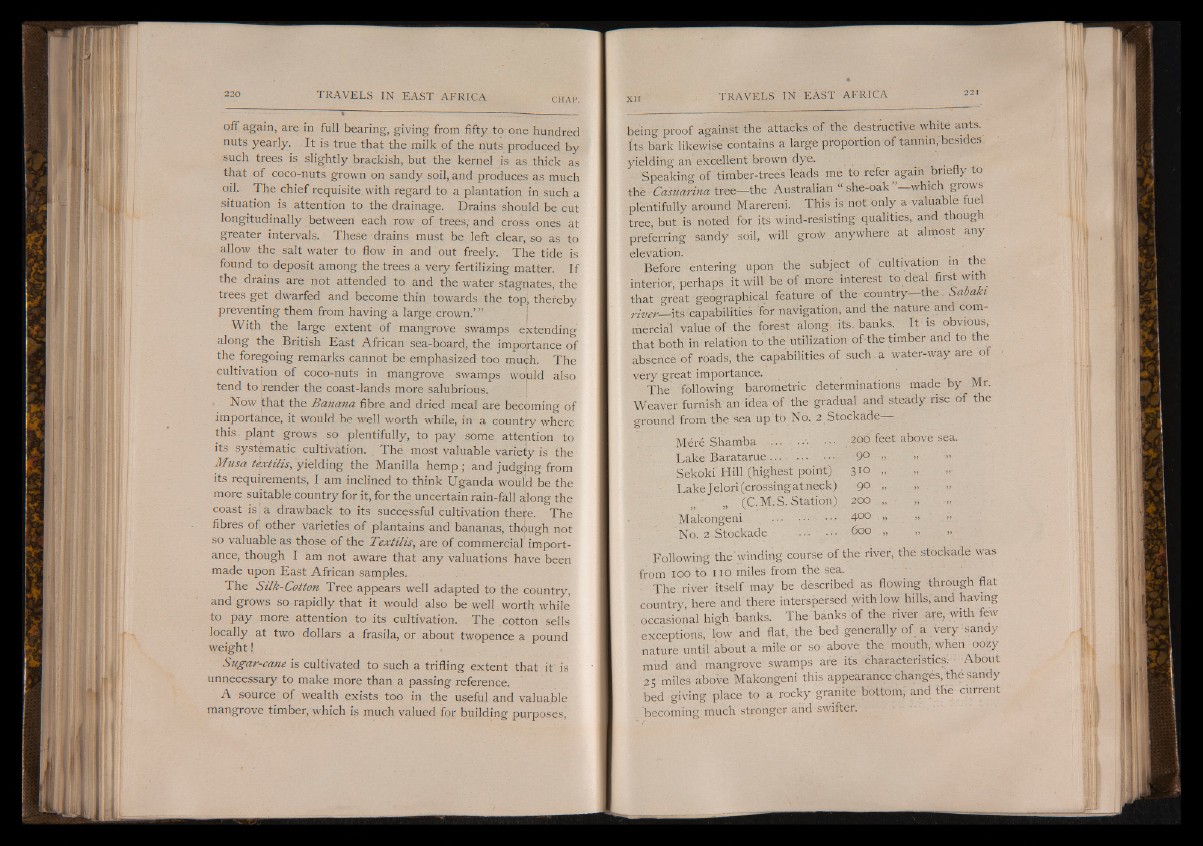
off again, are in full bearing, giving from fifty .to one hundred
nuts yearly. It is true that the milk of the nuts produced by
such trees is slightly brackish, but the kernel is as. thick as
that of coco-nuts grown on sandy soil, and produces as much
oil. The chief requisite, with regard to a plantation in such a
situation is attention to the drainage. Drains should be cut
longitudinally between each row of trees; and cross ones at
greater intervals. These drains must be left clear, so as to
allow the salt water to flow in and out freely. The tide is
found to deposit among the trees a very fertilizing matter. If
the drains are not attended to and the water stagnates, the
trees get dwarfed and become thin towards the top, thereby
preventing them from having a large crown.’ ”
With the large extent of mangrove swamps extending
along the British East African sea-board, the importance of
the foregoing remarks cannot be emphasized too much. The
cultivation of coco-nuts in mangrove swamps wojuld also
tend to Lender the coast-lands more salubrious.
Now jthat the Banana fibre and dried meal are becoming of
importance, it would be well worth while, in a country where
this, plant grows so plentifully, to pay some attention to
its systematic cultivation. Thé most valuable variety is the
Musa textilis, yielding the Manilla hemp ; and judging from
its requirements, I am inclined to think Uganda woul'd be the
more suitable country for it, for the uncertain rain-fall along the
coast is! a drawback to its successful cultivation there. The
fibres of other varieties of plantains and bananas, though not
so valuable as those of the Textilis, are of commercial importance,
though I am not aware that any valuations hâve been
made upon East African samples.
The Stlk-Cotton Tree appears well adapted to the country,
and grows so rapidly that it would also be well worth while
to pay more attention to its cultivation. The cotton sells
locally at two dollars a frasila, or about twopence a pound
weight !
Sugar-cane is cultivated to such a trifling extent that it is
unnecessary to make more than a passing reference.
A source of wealth exists too in the useful and valuable
mangrove timber, which is much valued for building purposes,
being proof against the attacks of thè destructive white ants.
Its bark likewise contains a large proportion of tannin, besides’.
yielding an excellent brown dye.
Speaking of timber-trees leads me to refer again briefly to
the Casuarina tree— the Australian “ she-oak -which grows
plentifully around Marereni. This is not only a valuable fuel
tree, but is noted for its wind-resisting qualities, and though
preferring sandy soil, will grow anywhere at almost any
elevation. .- . . ,,
Before entering upon the subject of cultivation in the
interior, perhaps it will be of more interest to deal first with
that great geographical feature of the country— the .. Sabaki
river— its capabilities for navigation, and the nature and commercial
value of the forest along' its. banks. It is obvious,
that both in relation to the utilization o f the timber and to the
absence o f roads, the capabilities of such a water-way are of
very great importance. . . . • \ , , - ,
The following barometric determinations made by Mr.
Weaver furnish an idea of the gradual and steady rise of the
ground from the s e a u p to No. 2 Stockade—
Méré Shamba g . 206 feet above sea.
Lake Baratarue ... ... • 9° » » »
Sekoki Hill (highest point); 310 „ „
Lake Jelori (crossing at neck) 90 „ „ »
1 1 I (C.M; S. Station) 200 „ j „
Makongeni ... • • • ••• 4° ° . » .. » ' . »
No. 2 Stockade 600
F o l l o w in g the w in d in g course of the river, the stockade was
from 100 to n o miles from the sea. ■ - '
The river itself may be dèscribed as flowing through flat
country here and there interspersed with low hills,’and having
occasional high 'banks. The banks of the river are, with few
exceptions, low and flat, the bed generally of a very -sandy
nature until about a mile or so above the mouth, when oozy
mud and mangrove swamps are it's charaeteristicsl - About
25 miles above. Makongeni this appearàncechanges, the sandy
bed giving place to a rocky granite bottom) and the current
becoming much stronger and swifter.